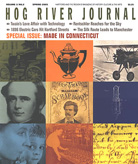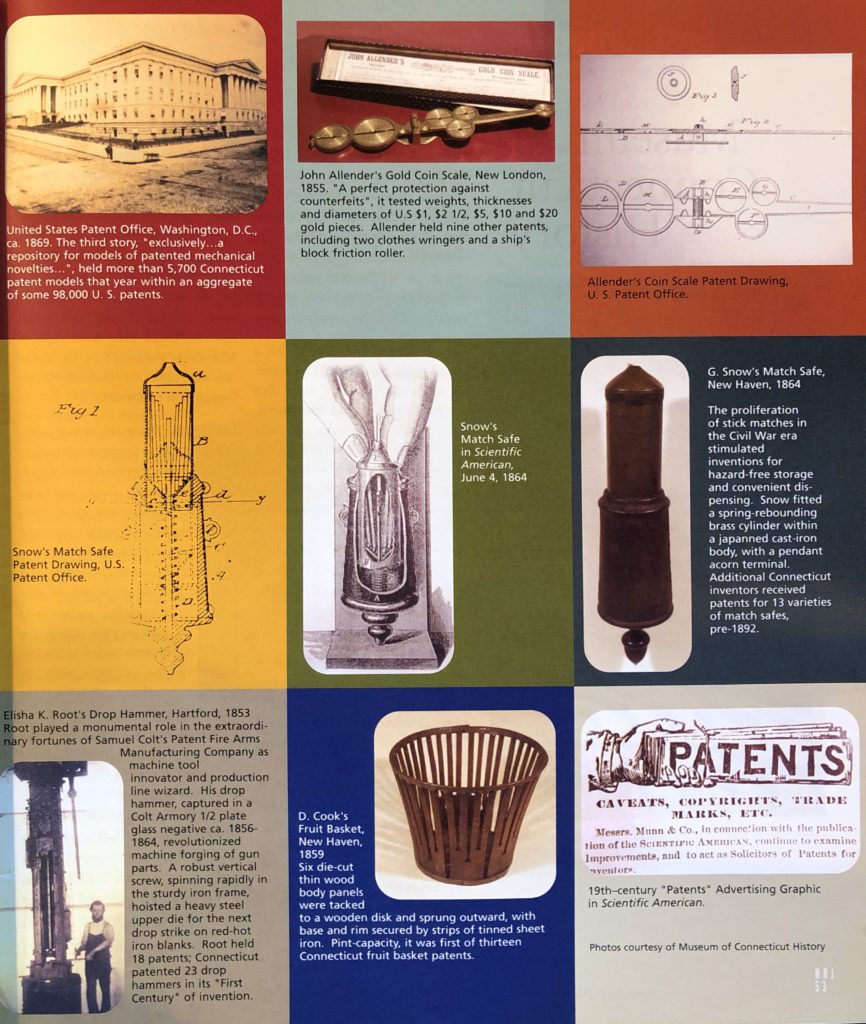(c) Connecticut Explored Inc. SPRING 2005
Subscribe/Buy the Issue!
President George Washington in 1790 signed America ‘s first patent law “to promote the progress of science and useful arts, by securing for limited times to authors and inventors the exclusive right to their respective writings and discoveries.” Inspired by the new law and its opportunities, Connecticut ‘s residents headed for their workbenches and a century later had been awarded more than 20,000 patents. From 1876 through 1890 the United States Patent Office saluted Connecticut as first in inventions per capita every year but three, when Nutmeggers came in second. To provide a unique, fascinating and easy way for identifying and better understanding Connecticut ‘s extraordinary phenomena of innovation, the Museum of Connecticut History has created the Connecticut Patents Database. Six years in the works and counting, it encourages forays into the state’s industrial legacy beyond the anecdotal and the glare of celebrity collectibles, in ways limited only by the imagination.
This searchable online database indexes the more than 20,000 pre-1891 Connecticut inventions (from the abdominal corset to the zinc tinning table) by 5,578 inventors (including 44 women) in all state towns. It includes patent date; the all-important patent number; inventors’ assignments of patents to manufacturers; and 44 convenient “subject code” categories such as “metal forming,” “nautical,” and “lighting devices.” Anyone, from the serious researcher to the casually curious, can access the database at www.cslib.org/patent.htm to run your own patent list queries. Then by searching the patent numbers, online drawings (regrettably, without text) can be found at the United States Patent Office Web site www.uspto.gov/patft . Researchers can also visit the Connecticut State Library’s Government and Information Services Unit to use the United States Patent microfilm on reader-printers for full text and drawings through 1871 and summaries and sample drawings thereafter. The full texts explain in detail what is special about a particular patent. An unusual exception, Mark Twain, perhaps due to his fame, slipped his 1871 adjustable garment strap through U.S. Patent Office strictures with his declaration “The advantages of such an adjustable and detachable elastic strap are so obvious that they need no explanation” as the official approved narrative.
Many of Connecticut ‘s inventions and manufactures found ready and widespread markets, producing wealth and reasonable living standards of living for management and most workers throughout the 19 th century. Other patents might have seemed useful on paper, but never did make it into production or gain consumer appeal. A high percentage of patented items actually made in the 19 th century bear the patent date only and lack marks to identify maker or origin. Other objects may only include the inventor’s name.
The Connecticut Patent database provides a “collector’s edge” by making it possible to quickly check dates or inventors’ names against the index to determine if a Connecticut connection puts something on a museum or private collector’s “must have” list. Schools can use the database as a springboard to examine early invention, inventors, and manufactures in their towns. Likewise, historical societies can develop custom patent reference binders to know local innovations and be aware of the possibilities and on the lookout for such things.
The Museum of Connecticut History looks forward to updating the list and posting online all drawings, full texts, new photos and even motion graphics of select collected inventions in operation. For more information on the Museum of Connecticut History , see page 54.
Read more about Connecticut industrial history and innovation on our TOPICS page
“Destination: Museum of Connecticut History,” Spring 2005
OR purchase
The Connecticut Brand Collection
6 issues: $35 (a $49 value!)
This collection features stories on Connecticut’s manufacturing and industrial history. You’ll read about products—some well known, some surprising—that were made or conceived in Connecticut. Delve into the places and people that made these products, and how Connecticut’s manufacturing past impacted the day-to-day lives of Connecticut’s people in places like Bridgeport, New Britain, Waterbury, and more!

